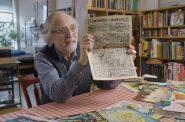Five Questions for Luckystar Studio’s Bridget Griffith Evans and Gene Evans
 TCD’s Kat Murrell talks with longtime Milwaukee artists Bridget Griffith Evans and Gene Evans of Luckystar Studio. The two are the catalysts for this Friday’s MAM After Dark: The Future Is Now, a one-night event featuring more than 19 artists, a selection of 15-minute features by filmmakers and video artists, along with dance and digital media performances.
TCD’s Kat Murrell talks with longtime Milwaukee artists Bridget Griffith Evans and Gene Evans of Luckystar Studio. The two are the catalysts for this Friday’s MAM After Dark: The Future Is Now, a one-night event featuring more than 19 artists, a selection of 15-minute features by filmmakers and video artists, along with dance and digital media performances.
1. How did Luckystar begin, and how long has it been going?
GE: Ten years, almost to the month. It was Oct. 15, 1999. It started really simple — we didn’t set out to do anything. [Bridget] lost some work in a basement — the apartment we first lived in when we moved here flooded.
BGE: I lost so much artwork.
GE: All her student work, and she lost a lot of work she was doing at the time.
I couldn’t see spending the money on a studio because prices were really kind of outrageous … so we would have to work, to do something to make money because we couldn’t pay for it. We needed something that would pay for itself.
BGE: In Chicago, for Carson Pirie Scott.
GE: When we first met, Bridget was selling jewelry on the sidewalk, and it was called Luckystar jewelry. We needed a name really quickly, and that is how it was named. I think if we had thought about it, it wouldn’t have been that. The name didn’t bother me until I had to answer the phone the first time…
BGE: We didn’t really intend for it to be what it became. It was more of a workspace and that’s what we were calling ourselves for these jobs we were doing.
2. What is “The Future Is Now” and how did that come together?
GE: It’s based on the comment (Andy) Warhol made about the future, when everyone would get their 15 minutes of fame. We figure now with Facebook, MySpace, social networking and YouTube that everyone becomes a star in their own right — literally, they get 15 minutes. Everyone does. And we thought that would be a great title for the show. We brought in artists from Milwaukee to do video work, to send us 15-minute videos. We built the show around that.
Corey Hengen, Bridget and I worked together on portraits — I want to say 50; we’re just finishing them up. We went to the MAM After Dark events for the past three months and took photographs of people — random, no picking, anyone who would let us.
BGE: Some people were kind of suspicious, like ‘Eh?”…
GE: We just wanted normal people, to make stars out of them, too. So, that’s part of the show.
3. You put together a touring exhibition that will be part of the MAM event, called “It Came From Milwaukee” — where has that been?
GE: It was supposed to go to five cites, but two of the galleries shut down because everyone was closing, and we pulled out of the show in Chicago. It went to St. Louis’ Mad Art Gallery — it’s an old police station. They have a really neat, proactive art scene. Really fun. And then Windover Center for the Arts in Fond du Lac, which is over a children’s museum, that was actually a really great crowd.
BGE: It was amazing; the turnout was incredible. People were thanking us — “Thanks for bringing the stuff here; it’s so different from what we usually see.”
GE: “It Came From Milwaukee” was 300 pieces at Mad Art, but because the Milwaukee Art (exhibit) has to be put up and taken down in the same day, and we’re only allowed so much space, we’re bringing a few pieces per artist.
BGE: Right, and a statement per artist.
4. How would you characterize the Milwaukee art scene?
BGE: I would say, if I had to use one word, it would be eclectic. There are so many things going on, so many niches. It seems like there’s a venue for every type of art somewhere.
GE: It’s hard to answer that. It’s hard to be involved and look at it from the outside because you can’t really get a perspective on what is going on in the scene – it’s kind of like watching your own ass.
5. As artists, what are some of your influences or things that inspire you?
BGE: I’m inspired by certain other artists — the Bay Area painters, Diebenkorn, Wayne Thiebaud, stuff like that — and everyday things. But, I can’t pinpoint a specific thing — I’m always finding something.
GE: I was more influenced by flyers; art by Jamie Reid, who did the Sex Pistols’ work. A lot of album covers. I actually did promotions for bands for years. Silkscreen, I’ve done since high school. But, no artist in particular — more music than art, I think.
BGE: Universally, I’ve always liked color. Color draws me in.
GE: It could make an odder pairing for work when we get it, because we don’t approach things the same. After ten years, there’s still a language barrier sometimes when we’re working together. All the Luckystar stuff now is done together; whereas before, one would take it and the other would add something. Now, it is 50/50.
It’s never gotten really easy; it’s never become something where we could relax when we take it. It’s really trying to get your point across and communicate with each other, and we do approach things with a different language, still.
MAM After Dark: The Future is Now
Friday, Nov. 20
5 p.m. to Midnight
For more info, check out the Luckystar Studio website
or MAM After Dark: The Future Is Now
Art
-
It’s Not Just About the Holidays
 Dec 3rd, 2024 by Annie Raab
Dec 3rd, 2024 by Annie Raab
-
After The Election Is Over
 Nov 6th, 2024 by Annie Raab
Nov 6th, 2024 by Annie Raab
-
The Spirit of Milwaukee
 Aug 30th, 2024 by Annie Raab
Aug 30th, 2024 by Annie Raab
Movies
-
Republican Legislators Push Tax Credits for Films Made in Wisconsin
 May 21st, 2025 by Baylor Spears
May 21st, 2025 by Baylor Spears
-
Mystery Movie Being Filmed in Milwaukee With Kevin Spacey
 Apr 24th, 2025 by Jeramey Jannene
Apr 24th, 2025 by Jeramey Jannene
-
Two Documentaries Offer Lessons in Fame
 Apr 24th, 2025 by Dominique Paul Noth
Apr 24th, 2025 by Dominique Paul Noth

















Thanks for the ink on Luckystar. Gene and Bridget are the real deal and their answers show both their maturity as artists and the personality that informs the work they do. Nice job.